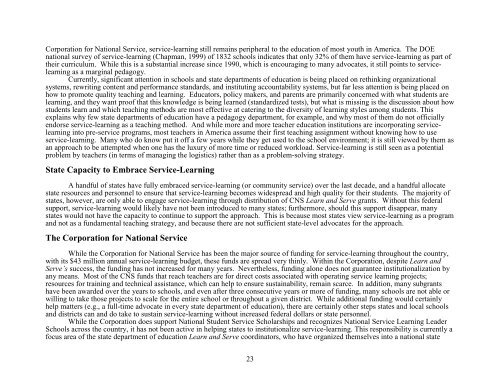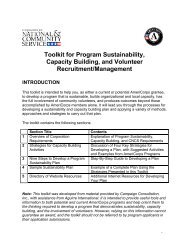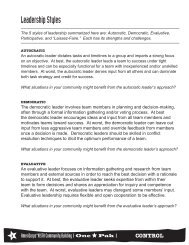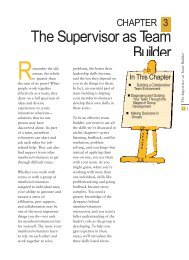MAKE IT LAST FOREVER: THE ... - National Service Resource Center
MAKE IT LAST FOREVER: THE ... - National Service Resource Center
MAKE IT LAST FOREVER: THE ... - National Service Resource Center
Create successful ePaper yourself
Turn your PDF publications into a flip-book with our unique Google optimized e-Paper software.
Corporation for <strong>National</strong> <strong>Service</strong>, service-learning still remains peripheral to the education of most youth in America. The DOE<br />
national survey of service-learning (Chapman, 1999) of 1832 schools indicates that only 32% of them have service-learning as part of<br />
their curriculum. While this is a substantial increase since 1990, which is encouraging to many advocates, it still points to servicelearning<br />
as a marginal pedagogy.<br />
Currently, significant attention in schools and state departments of education is being placed on rethinking organizational<br />
systems, rewriting content and performance standards, and instituting accountability systems, but far less attention is being placed on<br />
how to promote quality teaching and learning. Educators, policy makers, and parents are primarily concerned with what students are<br />
learning, and they want proof that this knowledge is being learned (standardized tests), but what is missing is the discussion about how<br />
students learn and which teaching methods are most effective at catering to the diversity of learning styles among students. This<br />
explains why few state departments of education have a pedagogy department, for example, and why most of them do not officially<br />
endorse service-learning as a teaching method. And while more and more teacher education institutions are incorporating servicelearning<br />
into pre-service programs, most teachers in America assume their first teaching assignment without knowing how to use<br />
service-learning. Many who do know put it off a few years while they get used to the school environment; it is still viewed by them as<br />
an approach to be attempted when one has the luxury of more time or reduced workload. <strong>Service</strong>-learning is still seen as a potential<br />
problem by teachers (in terms of managing the logistics) rather than as a problem-solving strategy.<br />
State Capacity to Embrace <strong>Service</strong>-Learning<br />
A handful of states have fully embraced service-learning (or community service) over the last decade, and a handful allocate<br />
state resources and personnel to ensure that service-learning becomes widespread and high quality for their students. The majority of<br />
states, however, are only able to engage service-learning through distribution of CNS Learn and Serve grants. Without this federal<br />
support, service-learning would likely have not been introduced to many states; furthermore, should this support disappear, many<br />
states would not have the capacity to continue to support the approach. This is because most states view service-learning as a program<br />
and not as a fundamental teaching strategy, and because there are not sufficient state-level advocates for the approach.<br />
The Corporation for <strong>National</strong> <strong>Service</strong><br />
While the Corporation for <strong>National</strong> <strong>Service</strong> has been the major source of funding for service-learning throughout the country,<br />
with its $43 million annual service-learning budget, these funds are spread very thinly. Within the Corporation, despite Learn and<br />
Serve’s success, the funding has not increased for many years. Nevertheless, funding alone does not guarantee institutionalization by<br />
any means. Most of the CNS funds that reach teachers are for direct costs associated with operating service learning projects;<br />
resources for training and technical assistance, which can help to ensure sustainability, remain scarce. In addition, many subgrants<br />
have been awarded over the years to schools, and even after three consecutive years or more of funding, many schools are not able or<br />
willing to take those projects to scale for the entire school or throughout a given district. While additional funding would certainly<br />
help matters (e.g., a full-time advocate in every state department of education), there are certainly other steps states and local schools<br />
and districts can and do take to sustain service-learning without increased federal dollars or state personnel.<br />
While the Corporation does support <strong>National</strong> Student <strong>Service</strong> Scholarships and recognizes <strong>National</strong> <strong>Service</strong> Learning Leader<br />
Schools across the country, it has not been active in helping states to institutionalize service-learning. This responsibility is currently a<br />
focus area of the state department of education Learn and Serve coordinators, who have organized themselves into a national state<br />
23










